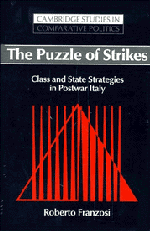Crossref Citations
This Book has been
cited by the following publications. This list is generated based on data provided by Crossref.
Celia, Gian Primo
1995.
Between Conflict and Institutionalization: Italian Industrial Relations in the 1980s and Early 1990s.
European Journal of Industrial Relations,
Vol. 1,
Issue. 3,
p.
385.
FRANZOSI, ROBERTO
1996.
A Sociologist Meets History Critical Reflections upon Practice.
Journal of Historical Sociology,
Vol. 9,
Issue. 3,
p.
354.
Turnbull, Peter
Morris, Julia
and
Sapsford, David
1996.
Persistent Militants and Quiescent Comrades: Intra-Industry Strike Activity on the Docks, 1947–89.
The Sociological Review,
Vol. 44,
Issue. 4,
p.
692.
Kelly, John
1997.
The future of trade unionism: injustice, identity and attribution.
Employee Relations,
Vol. 19,
Issue. 5,
p.
400.
Mikkelsen, Flemming
1997.
Cycles of struggle and innovation in industrial relations in Denmark after World War II.
Scandinavian Journal of History,
Vol. 22,
Issue. 1,
p.
31.
Tilly, Charles
1997.
Contentious politics and social change.
African Studies,
Vol. 56,
Issue. 1,
p.
51.
Kelly, John
1997.
Challenges to Unions in Britain and Europe.
Work, Employment and Society,
Vol. 11,
Issue. 2,
p.
373.
Franzosi, Roberto
1998.
Narrative as Data: Linguistic and Statistical Tools for the Quantitative Study of Historical Events.
International Review of Social History,
Vol. 43,
Issue. S6,
p.
81.
1998.
Book Reviews.
Journal of the American Statistical Association,
Vol. 93,
Issue. 441,
p.
397.
Ekiert, Grzegorz
and
Kubik, Jan
1998.
Collective Protest in Post-Communist Poland, 1989–1993: a Research Report.
Communist and Post-Communist Studies,
Vol. 31,
Issue. 2,
p.
91.
Seferiades, Seraphim
1999.
Unemployment, Informalization and Trade Union Decline in Greece: Questioning Analytical and Prescriptive Orthodoxies.
South European Society and Politics,
Vol. 4,
Issue. 3,
p.
60.
Rössel, Jörg
2000.
Mobilisierung und Streikverhalten.
Berliner Journal für Soziologie,
Vol. 10,
Issue. 3,
p.
403.
Walker, Henry A.
2000.
Three Faces of Explanation: Rethinking the Theory Project.
Sociological Focus,
Vol. 33,
Issue. 1,
p.
41.
Perrin, Andrew J.
2001.
The CodeRead System.
Social Science Computer Review,
Vol. 19,
Issue. 2,
p.
213.
Rössel, Jörg
and
Collins, Randall
2001.
Handbook of Sociological Theory.
p.
509.
Hyman, Richard
2001.
Trade Union Research and Cross-National Comparison.
European Journal of Industrial Relations,
Vol. 7,
Issue. 2,
p.
203.
Rigby, Mike
and
Aledo, Mari Luz Marco
2001.
The Worst Record in Europe?: A Comparative Analysis of Industrial Conflict in Spain.
European Journal of Industrial Relations,
Vol. 7,
Issue. 3,
p.
287.
Maceira, Daniel
and
Murillo, Victoria Victoria
2001.
Social Sector Reform in Latin America and the Role of Unions.
SSRN Electronic Journal,
McCAMMON, HOLLY J.
2001.
Labor's Legal Mobilization.
Work and Occupations,
Vol. 28,
Issue. 2,
p.
143.
Biggs, Michael
2002.
Strikes as Sequences of Interaction.
Social Science History,
Vol. 26,
Issue. 3,
p.
583.



